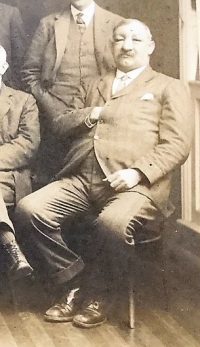
Alan Simpson, a resident of Richmond called into the musueum to tell us about his grandfather. After months of collecting stories from the time of the First World War for the Ribbon of Remembrance, we have our first story relating to our rural location.
Henry Barningham Simpson farmed at High Rockliffe Farm Hurworth during the First World War. He was also given the role of official horse buyer to the War Department during the conflict. Alan Simpson recalled, “I know he had to travel to very many farms selecting the best of the cart horses to pull the guns and carts of the army. My dad told me that he hated having to take the farmers best and most useful horses. He knew very well that a lot would be killed or injured from the shelling, ‘blown to pieces’ were his actual words. I suppose he was given some leeway in selecting which horses to buy as food still had to be produced, how they were selected he never said but I suppose they had to be fit for purpose whether they be cart horses or hunters for the cavalry”.
The requisitioning of horses during the First World War was dealt with by the Army Remount Service. This department existed before the conflict broke out, with a total establishment of 25,000 horses and mules, five Remount Depots and four Remount companies, with a strength of approximately 1,200 animals. Within 12 days, the establishment had been increased to 165,000 animals and a year later, in August 1915, to 534,971. At its peak in 1917, the Army establishment reached almost 870,000 horses and mules, with remount accommodation for 60,000 animals. Over the course of the war, a total of 468,323 horses were purchased in the United Kingdom by local offical horse buyers such as Henry Barningham Simpson.

Requisition order from the first day of the First World War
Explore more memories from the ribbon
-
Edward Barker
Edward was the Great Uncle of Robert Raw and Margaret Hird, who visited the museum during one of our Ribbon of Remembrance drop-in days. Edward, born in Richmond (he lived for at time along Frenchgate and then at 3 Maison Dieu) worked as a plumber for the North Eastern Railway, and enlisted after the outbreak of war in York. He became a Private in the 17th (Service) Battalion (NER Pioneers), a group whose skills were vital in constructing and maintaining the railways that developed behind the lines which kept the troops equiped and fed for the duration of the war. Edward was killed on 2nd November 1917, during the period where the battalion were working on light railways in the Ypres sector and suffered from shrapnel and gas shelling as well as high-explosives. Edward Barker is buried in Bard Cottage Cemetery, Belgium.
-
2nd Lieutenant Richard Birkenhead Wilton
Richard Birkenhead Wilton was the son of Charles and Elen Wilton of Stafford. After the outbreak of war Richard joined the 15th (Reserve) Battalion of the Yorkshire Regiment which had 12 officers and 750 non-commissioned officers and men. The battalion moved from Skipton to Rugeley in Staffordshire. In January 1916 Richard is listed as a temporary Second Lieutenant in the Reserve battalion. November 1916 sees him transfered at that rank to the 9th battalion. The Green Howards Gazette records that Richard was Killed in action on 1st October 1917. On the night of 30th September the 9th battalion took over from the 8th battalion in the line where the war diary states “Very heavy barrage put up by enemy from 4.30am; ‘C’ Coy on our left attacked; heavy casualties feared. Communication between HQs and Coys very difficult” His death is recorded on the Tyne Cot Memorial in Belgium.
-
2nd Lt. Hadow
Gerald Francis Hadow was born in Scarborough in 1895, the son of Colonel A de S Hadow of the XIX Regiment of Foot (the Green Howards). He was commisioned as a Second Lieutenant on 15th August 1914 and promoted to Lieutenant in March 1915. His first actions were at the battles of neuve Chapelle and Festubert. His death at Givenchy on 15th June 1915 was recorded at the time: “He had reached the German barbed wire and finding he was practically alone, returned to his own trenches, which he reached untouched. Here he found his captain killed and all the other officers dead or wounded. His company went into action 180 strong and had 142 casualties. he returned to report to the C.O. and on the way, was struck on the head by a piece of shell. A captain under whom he served wrote; ‘I feel I have lost a young friend whom I had got to know and tested in perhaps the most severe time – war time – and he never failed. He was such a gallant little fellow and quite ready to die for the good cause.’”
